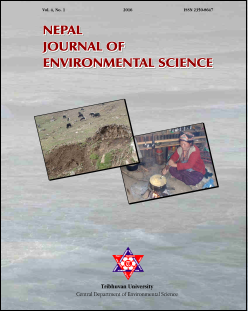Community forestry and livelihood linkages: A case of Kamalamai community forest, Dolakha, Nepal
DOI:
https://doi.org/10.3126/njes.v4i0.22722Keywords:
Capitals, Forest Management, JudgmentalAbstract
As a result of institutional failure of the nationalization of forest in 1957 A.D., a newer concept of participatory forest management was introduced in Nepal and local people got their space created in forest management during 1970s with a view to mitigating forest cover loss. Under this scheme Kamalmai Community Forest (129.59 hectares) located in Laduk VDC of Dolakha District was handed over to the community in 2000 A.D. The present study was conducted during February, 2014 to assess the status of forest management strategies and impact on livelihood of forest dependent people. Management aspect of the forest was assessed based on field observation, Key Informant Interview and Focus Group Discussion, whereas judgmental scoring method was used to assess the impact on livelihood; the questionnaire for which was prepared on the basis of Sustainable Livelihood Framework Guidance Sheet developed by Department for International Development (DFID), 1999. All the forest management practices including control of composition and structure of growing stock, and harvesting and distribution of forest products were strictly implemented. The total average scores for human, physical, social, financial and natural capitals, which were used to assess the livelihood, were found to be 2.5862, 1.4310, 2.5689, 0.2068 and 2.6896 respectively. The result illustrated that the forest under study had contributed to enhance the condition of human, social and natural capitals. The contribution was noticeable in terms of physical capital, but financial capital was not found satisfactory. Since the handover, there has been a notable change in greenery and landscape as well as on livelihood of forest dependent people.
Downloads
Downloads
Published
How to Cite
Issue
Section
License
This license enables reusers to distribute, remix, adapt, and build upon the material in any medium or format for noncommercial purposes only, and only so long as attribution is given to the creator.




